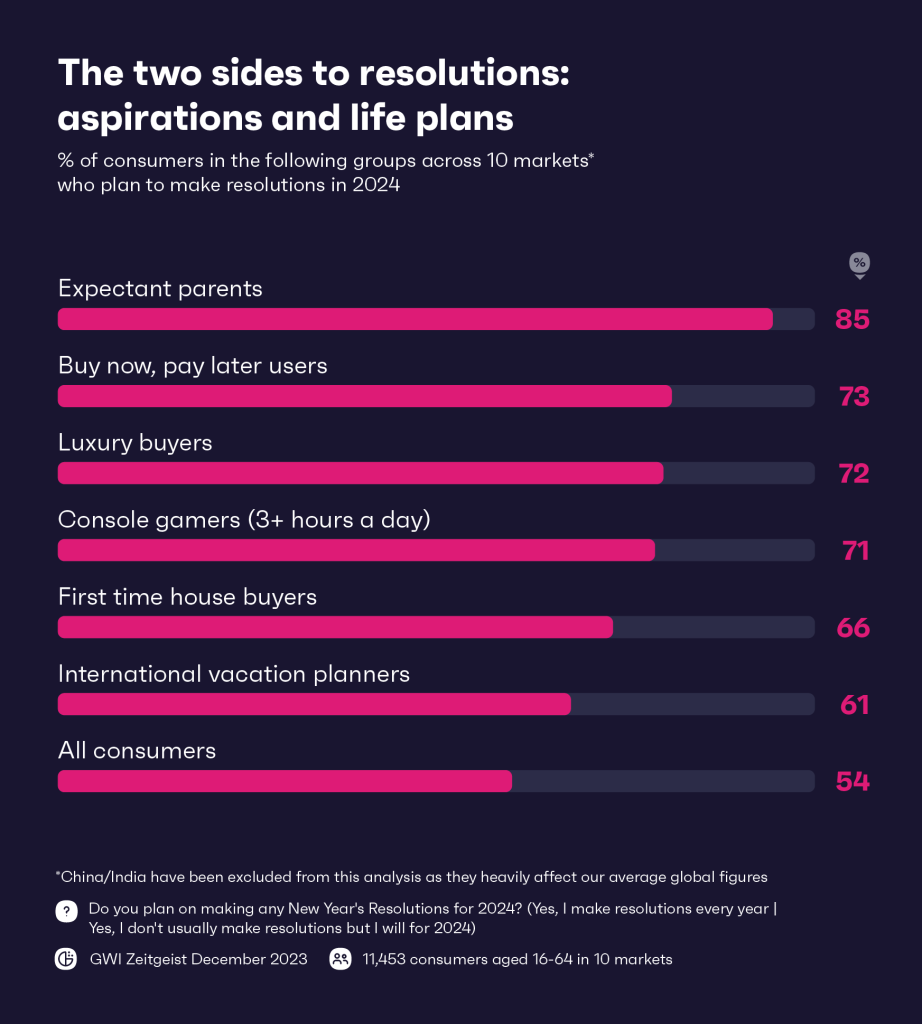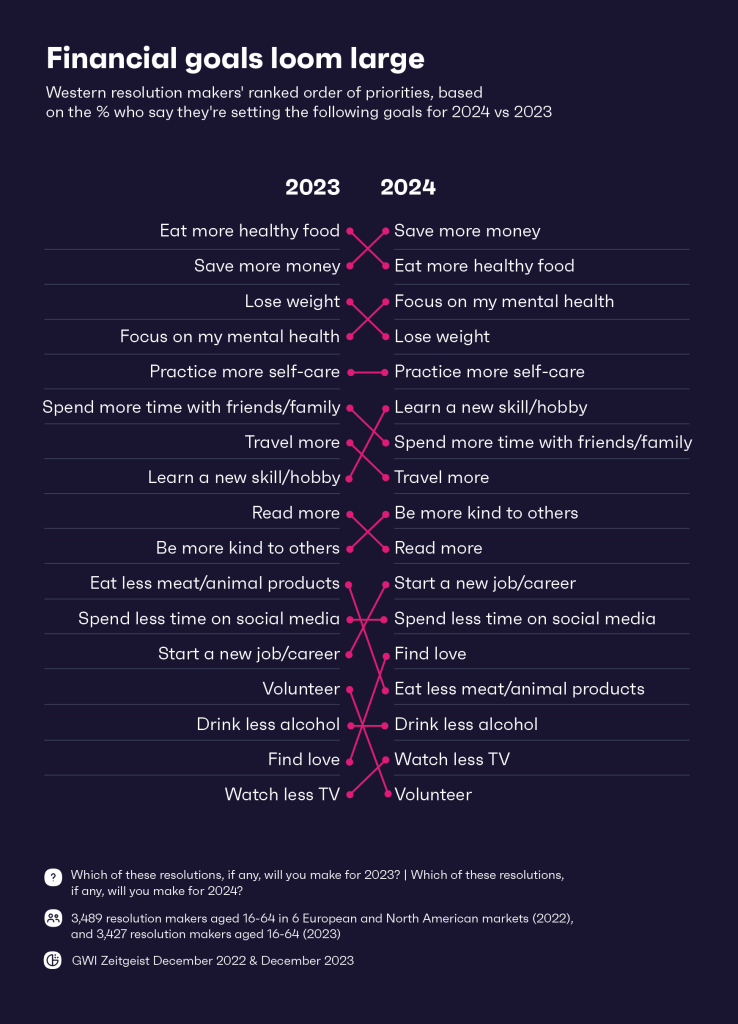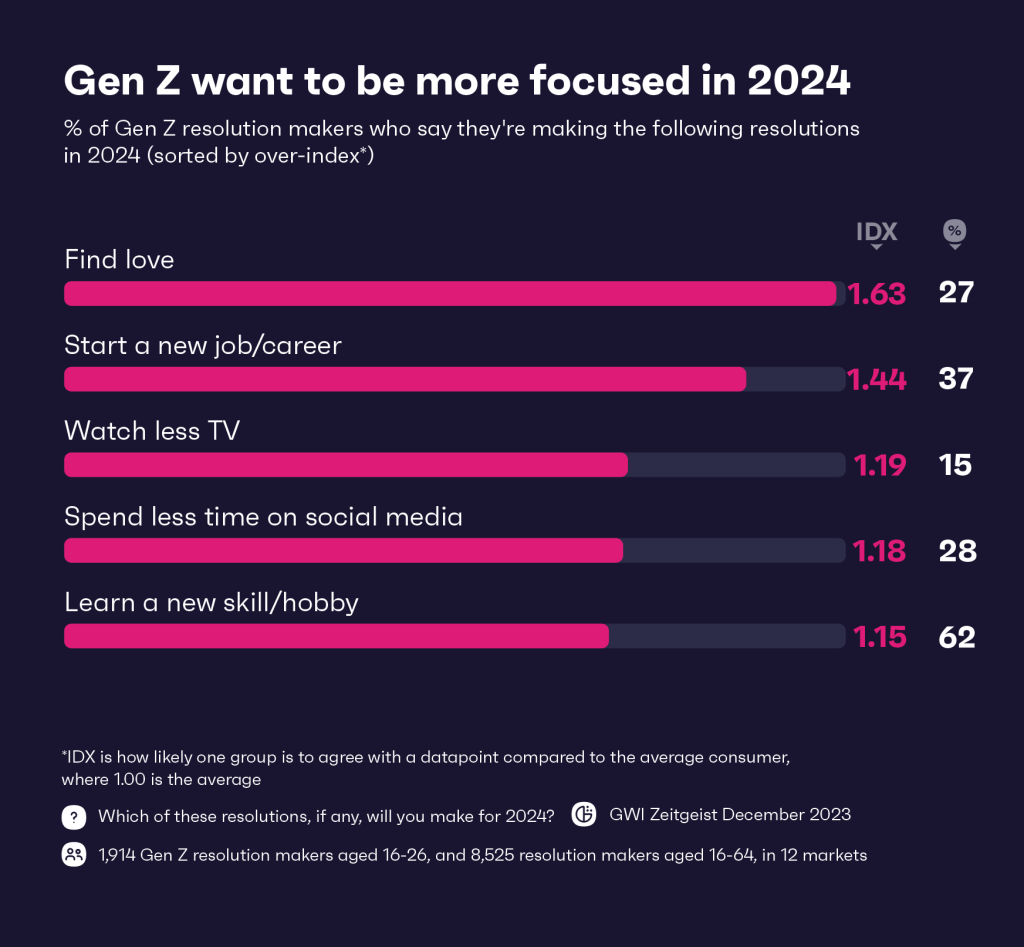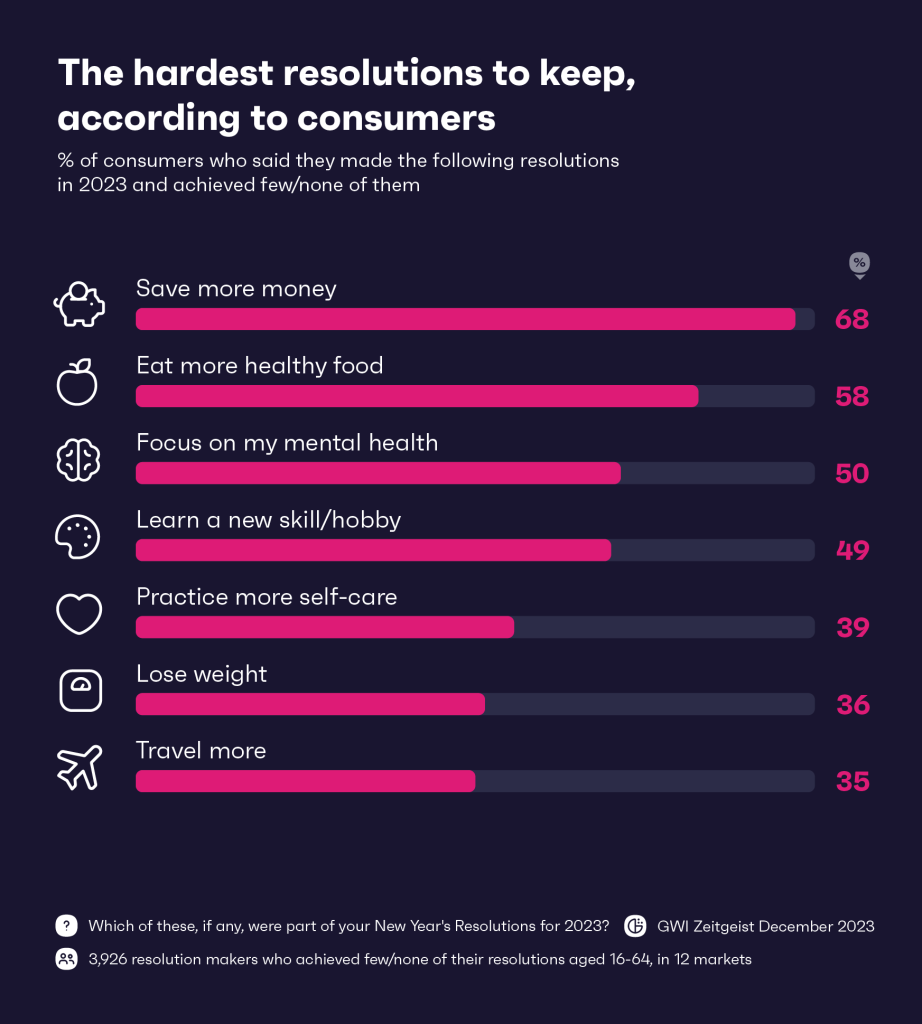The beginning of each year brings a fresh wave of new year’s resolution articles, all offering a hot new take on whether making resolutions is sustainable, if they’re valuable, and the best ways to keep them.
We’re not about to add to that debate (we’re no self-help gurus). Instead, we’ll give you the scoop on the top new year resolutions, and what they tell us about 2024 consumer trends.
2024 New Year’s Resolutions trends:
1. Making New Year’s Resolutions is still popular.
2. Saving money is at the top of consumers’ priority list.
3. People are looking for new ways to enrich their lives.
4. Overall wellbeing matters more than losing weight.
5. Meat consumption isn’t a main focus this year.
6. Resolutions are hard to keep, some more than others.
1. Making New Year’s Resolutions is still popular
In recent years, we’ve seen certain behaviors, like reading the news and staying eco-conscious, drop off due to people feeling exhausted or overwhelmed. You may assume that goal-making has also taken a hit, alongside general optimism. But this isn’t the case.
Overall, 71% of consumers plan to make a resolution this year.
This number is boosted by places like China and India, but it applies to around half outside these markets as well.
The number of Americans who report tracking their spending (+16%), screen time (+21%), sleep (+13%), and exercise (+12%) have all climbed in the last two years. For whatever reason, 2024’s consumers seem keen to keep tabs on their goals, and many have their resolution lists ready.

Groups like expectant parents and luxury buyers stand out for making new year’s resolutions, which show there’s two sides to them: some take the form of aspirations, and others as life plans.
First-time home buyers and expectant parents scoring highly here may suggest that new year’s resolutions are more popular among people with a big change coming; while luxury buyers and buy now, pay later users are generally more aspirational individuals who want to start taking control of their spending, which may go some way to explaining why “capsule wardrobes” are on trend.
These are ultimately very in-demand consumer segments, and understanding this group’s motivations and goals will help brands tailor their messaging in 2024.
2. Consumers are focused on saving money
Last year, eating more healthily was Western consumers’ number one resolution. Covid restrictions had eased in 2022, and many people had the savings they racked up during 2020-21, which gave them more room to focus on improving their lifestyle.
This year, it’s been overtaken by saving more money, which speaks to the current climate.

Even though inflation’s falling, prices are much higher than they used to be and consumers are struggling to deal with rising costs.
Since October 2022, we’ve seen a 47% rise in consumers saying they rarely follow a budget, suggesting that it’s become harder for people to stick within their means. And when turning to banks for assistance, we’ve seen a 19% increase in consumers wanting guidance on taking out loans. The media has labeled this behavior “doom-spending” – splurging on impulsive delights to cope with a spiraling economy.
Clearly, saving is difficult at the moment, and our data reflects that.
Only 18% of those who resolved to save more money in 2023 said they achieved most or all of their goals.
This challenge is especially real for younger consumers, many of whom have recently left home, are hoping to start a family, and travel more. It’s a delicate balancing act between saving and spending, and tips on how to enjoy life in a more modest fashion – rather than sacrifice key experiences to achieve life goals – will land well.
Topdeck Travel, for example, provides group travel experiences for 18-30 year olds. Customers pay one affordable amount beforehand, covering everything (meals, accommodation, activities, and transport), which makes it easier for them to budget.
Younger people also have a lot of online temptation, and resolution makers are much more likely to have a short-term loan. This highlights just how big the fintech opportunity is in 2024, and suggests the sector isn’t currently meeting the needs of its customers.
3. People are looking for new ways to enrich their lives
Other goals that have climbed the resolution rankings are learning a new skill or hobby, starting a new job or career, and finding love.
There’s been a 42% increase in UK/US consumers wanting a new job, and a 23% increase in those wanting to find love since this time last year.
While workers might not necessarily be leaving jobs, they feel empowered enough to plan for it. Companies should aim to make their employees feel like stakeholders, especially in markets like the US and UK.

Gen Z also stand out for wanting to start a new job and find love, so they’ll be a key market for dating apps and recruitment sites to target in 2024.
Beyond that, Gen Z also score higher for wanting to scroll and watch TV less – a sign they want to use their time more productively and regain focus. Apps that encourage healthy habits and IRL (in real life) experiences are likely to be a hit among this generation, especially when it comes to love and relationships.
4. Consumers are prioritizing overall wellbeing over losing weight
This year, focusing on mental health has overtaken losing weight on consumers’ priority list in Western markets. In the US/UK, this is actually the first time it’s happened since we started tracking resolutions in 2020.
Eating more healthy food has also always ranked higher than losing weight for new year’s resolutions, showing that consumers have a fairly holistic attitude toward their health.
Still, perceptions of health are always moving, with two-thirds of US/UK consumers saying that what it means to be ‘healthy’ has changed in the last decade, which is why our next point may surprise you.
5. Eating fewer animal products isn’t front of mind
While society’s focus on wellbeing has increased, food & drink, health, and lifestyle brands need to keep track of shifting ideals. Eating less animal products has fallen down the resolution priority list over time, which ties into wider trends we’ve spotted.
In our latest Connecting the dots report, we highlighted veganism’s drop in popularity, as people move toward less restrictive diets like flexitarianism.
The number of Europeans describing themselves as meat-eaters interested in reducing their meat consumption is much higher than the number identifying as vegan, a sign that brands selling plant-based products should cater more to those in the middle.
That’s not all. Probiotic ingredients are trending, with fat-free food taking a hit after digestive problems escalated during the pandemic. And protein products have generally been making headway in our data over the last two years.
There’s been a 23% year-on-year jump in Europeans saying they prefer high protein food.
Brands who advertise trending ingredients and qualities are likely to draw in new customers, and it’s easy to profile key groups like flexitarians using our granular audience data.
6. Many people think resolutions are too hard to keep
Something brands can also keep in mind are consumers’ grounds for not taking part or giving up on new year’s resolutions, as these will help drive motivation across 2024.
There’s a reason why many people don’t make these goals in the first place: they can be a lot of work. Among those who aren’t making new year’s resolutions this year, their explanations include: them being too hard to keep (35%), too much pressure (25%), and not having time to focus on them (19%). And this is true of some resolutions more than others.

Perhaps unsurprisingly, the new year’s resolutions consumers find most difficult to keep are saving more money and eating more healthily. Today, financial wellbeing is as tricky (if not, trickier) to manage as emotional and physical wellbeing, and all of them are in some way related.
Brands can help consumers to keep their resolutions by introducing gamified experiences that inject a sense of fun into their goals. Monzo’s own version of “Spotify Wrapped” provides users with a simple and fun overview of their spending habits and progress toward financial goals, gamifying a typically bland experience. Mimicking this approach could be an effective way for brands to build engagement with their customers and support them in the year ahead.
Apps like “Five Minute Journal” and Duolingo, which facilitate regular check-ins and encourage consumers to meet their targets by taking small steps, are also good models.
Whatever your industry, inspiring motivation among your customers is a good goal for 2024, and our consumer insights can help make this resolution stick.









